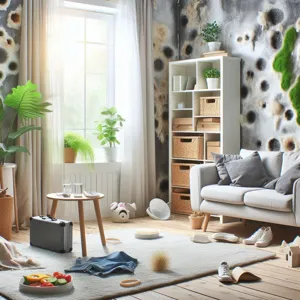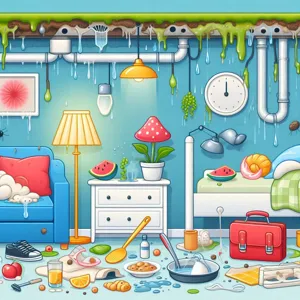Mold and mildew can be unwelcome guests in any home, thriving in damp, dark corners and often leading to significant health issues and costly repairs.
With their ability to multiply quickly, these fungi can create a host of problems if left unchecked, from musty odors to respiratory problems and structural damage. The good news is that prevention is key, and with the right strategies in place, you can keep your home mold-free and foster a healthier living environment. In this blog post, we’ll explore the top strategies for mold and mildew prevention, offering practical tips to help you identify potential problem areas, maintain optimal humidity levels, and implement effective cleaning routines. Say goodbye to the worry of mold and mildew, and hello to a cleaner, safer home!
1. Understanding Mold and Mildew: Definitions and Differences

To effectively combat mold and mildew in your home, it’s crucial to first understand what they are and how they differ. While the terms are often used interchangeably, they refer to distinct types of fungi that can take root in our living spaces.
Mold is a type of fungus that appears in various colors, including green, black, yellow, and white. It thrives in damp, warm environments and can penetrate and damage the materials it grows on, such as wood, drywall, and fabric. Mold spores are microscopic and can travel through the air, making it easy for them to spread throughout your home. Some molds can produce allergens or irritants and can even lead to more serious health issues, especially for those with respiratory conditions or weakened immune systems.
On the other hand, mildew is a specific type of mold that typically presents as a white, powdery substance. Often found in areas with high humidity, such as bathrooms and kitchens, mildew can usually be wiped away with a simple cleaning solution. While it may not be as harmful as some types of mold, it can still lead to unpleasant odors and potential health concerns if left untreated.
Understanding these distinctions is the first step in protecting your home. By recognizing the environments in which mold and mildew thrive, you can implement effective strategies to prevent their growth and maintain a safe and clean living space. With proper knowledge and proactive measures, you can ensure your home remains a healthy haven—free from the clutches of these unwanted fungi.
2. The Health Risks Associated with Mold Exposure
Mold and mildew are not just unsightly nuisances; they pose significant health risks that can affect anyone, particularly those with preexisting conditions or compromised immune systems. When mold spores are inhaled, they can trigger a cascade of respiratory issues, ranging from mild allergies to severe asthma attacks. Symptoms may include sneezing, runny or stuffy noses, coughing, and itchy or watery eyes. For individuals with asthma, exposure to mold can exacerbate symptoms, leading to more frequent and severe attacks.
Beyond respiratory complications, mold exposure can also cause skin irritations and rashes, headaches, and fatigue. In some cases, prolonged exposure to certain types of mold, such as Stachybotrys chartarum (commonly known as black mold), can lead to more serious health concerns, including neurological symptoms and immune system suppression. The risk is particularly acute for vulnerable populations, including children, the elderly, and those with preexisting health conditions, as their bodies may not respond as effectively to mold exposure.
Understanding the health risks associated with mold is crucial for homeowners. It serves as a vital reminder that effective prevention and prompt remediation are not just about maintaining the integrity of your living space; they are essential for safeguarding your family’s health. By staying informed and proactive, you can create a safer, healthier home environment that minimizes the likelihood of mold growth and protects those who live within it.
3. Identifying Common Areas for Mold Growth

Identifying common areas for mold growth in your home is a crucial step in prevention. Mold thrives in damp, warm environments, making certain spaces more susceptible to infestations. Start with your bathrooms, where humidity levels can skyrocket after hot showers. Pay special attention to corners, behind toilets, and under sinks, as these areas often trap moisture.
Kitchens also warrant close inspection. Look beneath the sink, around dishwashers, and behind refrigerators where condensation can build up. Any leaks from plumbing or appliances should be addressed immediately to minimize moisture accumulation.
Basements and crawl spaces are notorious for mold growth due to their typically cooler and more humid conditions. Ensure these areas are well-ventilated and consider using dehumidifiers to keep humidity levels in check.
Don’t overlook laundry rooms, especially if you have a washer and dryer located in a basement or poorly ventilated area. A damp towel left in the washer for too long can lead to mold growth, so make it a habit to remove clothes promptly.
Lastly, check your home’s exterior. Gutters that are clogged or not draining properly can lead to water pooling around the foundation, creating an ideal breeding ground for mold. By identifying these common areas and taking proactive measures, you can effectively reduce the risk of mold and mildew taking hold in your home. Regular inspections and maintenance are key to ensuring a safe and healthy living environment.
4. Importance of Proper Ventilation in Your Home
Proper ventilation is a cornerstone of mold and mildew prevention, acting as a silent guardian against the damp conditions that these unwanted invaders thrive on. When air is allowed to circulate freely within your home, it helps to regulate humidity levels, ensuring that moisture does not accumulate in corners, closets, or other hidden spaces.
Imagine your home as a living organism; just like breathing is essential for our health, adequate airflow is crucial for your living space. In areas prone to high humidity, such as bathrooms, kitchens, and basements, the introduction of fresh air can significantly reduce the chances of mold growth. This is especially important during the warmer months when humidity levels soar and indoor air can become stagnant.
To achieve optimal ventilation, consider installing exhaust fans in moisture-heavy areas to expel humid air directly outside. Additionally, opening windows and doors to promote cross-ventilation can create a refreshing breeze that helps to dry out damp surfaces. It may also be beneficial to invest in a dehumidifier for spaces that struggle with excess moisture; this device works tirelessly to remove humidity from the air, providing a dry environment that is inhospitable to mold spores.
Regular maintenance is key as well. Ensure that your ventilation systems, such as HVAC units and ductwork, are clean and functioning properly to maximize airflow. If you have a chimney or attic, be sure they are adequately ventilated to prevent moisture build-up. By making ventilation a priority in your home, you not only enhance air quality but also create a less inviting environment for mold and mildew, allowing you to enjoy a healthier, more comfortable living space.
5. Controlling Humidity Levels: Ideal Ranges and Tools

When it comes to mold and mildew prevention, controlling humidity levels is one of the most crucial aspects of maintaining a healthy home environment. Mold thrives in damp conditions, making it essential to keep indoor humidity within an ideal range of 30% to 50%. This range not only hinders the growth of mold spores but also contributes to overall comfort and air quality within your home.
To monitor and manage humidity levels effectively, consider investing in a hygrometer—a simple yet effective tool that measures the moisture in the air. Placing hygrometers in key areas, such as your basement, kitchen, and bathrooms, can provide you with real-time data on humidity fluctuations. If you find that certain areas consistently exceed the recommended levels, it’s time to take action.
There are several tools and methods available to help control humidity. Dehumidifiers are a popular choice, particularly in basements and other damp areas. These units work to extract moisture from the air and can significantly reduce humidity levels. Make sure to choose a model that suits the size of the space you’re treating for maximum effectiveness. Additionally, using exhaust fans in bathrooms and kitchens during and after activities that generate moisture, like cooking or showering, is another effective strategy to lower humidity levels.
Natural ventilation is also key. Opening windows and doors when weather permits can help circulate fresh air and reduce indoor humidity. If outdoor humidity levels are high, however, it may be wise to keep windows closed and rely on air conditioning, which typically dehumidifies as it cools, to maintain a comfortable indoor environment.
By actively controlling humidity levels in your home, you not only deter mold and mildew growth but also promote a more pleasant living space for you and your family. Remember, a proactive approach to humidity management is not just a seasonal task but an ongoing commitment to safeguard your home from the perils of excessive moisture.
6. Best Practices for Bathroom and Kitchen Maintenance
Bathrooms and kitchens are the most common breeding grounds for mold and mildew in any home, primarily due to the high levels of moisture generated in these areas. Implementing best practices for maintenance in these spaces is crucial for mold prevention and overall hygiene.
First and foremost, ensure proper ventilation. Install exhaust fans in bathrooms and kitchens to help eliminate moisture. When showering or cooking, run these fans to pull excess humidity from the air. If your kitchen or bathroom lacks a fan, consider opening windows or doors to promote airflow, especially during and after activities that generate steam or moisture.
Regular cleaning is another essential practice. Use mold-inhibiting cleaners on surfaces prone to dampness, such as tiles, grout, and countertops. Pay special attention to corners, seams, and any areas where water tends to accumulate. A solution of vinegar and water can effectively prevent mold growth, as vinegar is known for its antimicrobial properties.
Additionally, inspect plumbing fixtures for leaks or drips, as even minor leaks can create an environment conducive to mold. If you identify any leaks, address them promptly to minimize water accumulation.
Lastly, consider the use of dehumidifiers in particularly humid climates or seasons. These devices can significantly reduce moisture levels in the air, making it harder for mold spores to settle and thrive. Incorporating these best practices into your bathroom and kitchen maintenance routine will help create a healthier living space, free from the threat of mold and mildew. By taking these proactive steps, you not only protect your home but also enhance your overall well-being.
7. How to Inspect and Maintain Your Roof and Gutters

Maintaining the integrity of your roof and gutters is a foundational strategy in preventing mold and mildew from taking hold in your home. A well-functioning roof not only shields your living space from the elements but also plays a crucial role in managing moisture levels—one of the main contributors to mold growth. Regular inspections and maintenance can help you catch potential issues before they escalate into costly repairs and serious health hazards.
Start by conducting a visual inspection of your roof at least twice a year, ideally in the spring and fall. Look for signs of damage, such as missing or cracked shingles, rusted flashing, or accumulated debris. Pay special attention to areas prone to water pooling, as standing water can lead to leaks over time. If your roof is more than 20 years old, consider consulting a professional to evaluate its condition thoroughly.
Equally important is the maintenance of your gutters. Clogged gutters can cause water to overflow and seep into your home, creating the perfect environment for mold and mildew to thrive. Clean your gutters regularly—at least twice a year, or more often if you live in a wooded area. Remove leaves, twigs, and other debris that can hinder water flow. Ensure that downspouts direct water at least three to four feet away from your foundation to prevent moisture accumulation.
While you’re at it, check for proper gutter slope and alignment; gutters should have a slight incline towards the downspouts to facilitate efficient drainage. If you notice sagging gutters or any signs of rust, it may be time for repairs or replacements.
By taking the time to inspect and maintain your roof and gutters, you can significantly reduce the risk of moisture intrusion and mold growth in your home. This proactive approach not only protects your living environment but also enhances the longevity of your property, ensuring a safe and healthy space for you and your family.
8. The Role of Insulation in Mold Prevention
When it comes to mold and mildew prevention in your home, insulation plays a surprisingly pivotal role that often goes overlooked. Proper insulation not only regulates your home’s temperature but also creates a barrier against moisture—a key contributor to mold growth. When areas of your home are poorly insulated, they become susceptible to temperature fluctuations that can lead to condensation, particularly in attics, basements, and crawl spaces.
When warm, moist air encounters cold surfaces, such as inadequately insulated walls or ceilings, it cools down and releases moisture in the form of condensation. This damp environment is ideal for mold spores to thrive and multiply. By investing in high-quality insulation, you are effectively reducing the risk of these temperature-induced condensation issues.
Fiberglass, foam board, and spray foam insulation are excellent choices to consider. They not only provide thermal resistance but also help maintain a consistent temperature throughout your home, minimizing the likelihood of moisture accumulation. Additionally, insulated ductwork can prevent condensation from forming in your heating and cooling systems, which can also become a breeding ground for mold.
Moreover, insulation can enhance your home’s energy efficiency, leading to lower utility bills while simultaneously keeping your indoor environment healthier. It’s a twofold solution: you protect your home from the damaging effects of mold and mildew while ensuring that your living spaces remain comfortable.
In summary, the role of insulation in mold prevention cannot be overstated. By ensuring that your home is well-insulated, you create a less hospitable environment for mold growth, safeguarding your health and preserving the integrity of your home for years to come.
9. Effective Cleaning Techniques for Mold-Prone Areas
Maintaining a mold-free home begins with understanding the areas most susceptible to mold growth—typically those that are damp, dark, and poorly ventilated. In this section, we will explore effective cleaning techniques specifically tailored for mold-prone areas, ensuring your efforts yield lasting results.
**1. Focus on High-Risk Spots:** Start by identifying the hot spots in your home where moisture tends to accumulate, such as bathrooms, kitchens, basements, and laundry rooms. These areas require routine attention to prevent mold spores from taking root.
**2. Use the Right Cleaning Solutions:** While there are numerous commercial cleaners available, many effective cleaning solutions can be made right at home. A mixture of equal parts vinegar and water is a powerful natural cleaner that can disrupt mold growth without harsh chemicals. For tougher spots, consider a solution of hydrogen peroxide or a diluted bleach mixture (always remember to use bleach with caution and ensure proper ventilation).
**3. Scrub and Dry Thoroughly:** When tackling mold, scrubbing is key. Use a stiff brush to scrub away visible mold from surfaces. Once you’ve cleaned the area, ensure it dries completely, as lingering moisture can lead to regrowth. For larger areas, a wet/dry vacuum can efficiently remove excess water and moisture.
**4. Ventilation is Vital:** After cleaning, improving ventilation in mold-prone areas can significantly reduce moisture levels. Consider using exhaust fans in bathrooms and kitchens, and open windows when possible to promote airflow. A dehumidifier can also be a great investment to keep humidity levels in check, particularly in basements or other enclosed spaces.
**5. Regular Maintenance:** Make cleaning mold-prone areas part of your regular home maintenance routine. Schedule inspections and cleanings at least once a month to keep any potential mold growth at bay. This proactive approach will not only keep your home looking pristine but will also enhance your overall indoor air quality.
By implementing these effective cleaning techniques in mold-prone areas of your home, you can significantly reduce the likelihood of mold growth, creating a healthier and more inviting living environment for you and your family. Remember, the key to mold prevention lies not just in cleanup but in consistent vigilance and maintenance.
10. Choosing Mold-Resistant Products for Home Improvement
When it comes to mold and mildew prevention, one of the most effective strategies is incorporating mold-resistant products during any home improvement projects. These specially designed materials can significantly reduce the risk of mold growth, especially in areas prone to moisture, such as bathrooms, kitchens, and basements.
Start by considering mold-resistant drywall, also known as green board or cement board, which is treated to resist moisture. This type of drywall is ideal for high-humidity areas, as it provides a robust barrier against water penetration. Similarly, when selecting paint for these spaces, opt for mold-resistant paint that contains antimicrobial properties, preventing mold spores from taking hold on your walls.
In addition to these materials, think about incorporating mold-resistant flooring options. Vinyl, tile, and specific treated wood products can withstand damp conditions far better than traditional carpeting, which can trap moisture and promote mold growth. For outdoor projects, consider using composite decking materials that resist moisture and are less susceptible to mold compared to conventional wood.
Additionally, remember to select mold-resistant insulation and sealants, especially around windows and doors, to create airtight seals that prevent moisture accumulation. By being strategic about the products you choose for your home improvement projects, you not only enhance the durability of your home but also create a healthier living environment. Investing in these mold-resistant options is a proactive step towards protecting your home from the pervasive threat of mold and mildew, ensuring your living spaces remain safe, clean, and comfortable for years to come.
11. Seasonal Tips for Mold Prevention
As the seasons change, so too do the conditions that can contribute to mold and mildew growth in your home. Understanding these seasonal dynamics and adjusting your prevention strategies accordingly is crucial for maintaining a healthy living environment.
**Spring** heralds warmer temperatures and increased humidity, creating a perfect breeding ground for mold spores. To combat this, ensure that your gutters are clean and functioning properly to divert rainwater away from your foundation. Additionally, consider investing in a dehumidifier for particularly damp areas of your home, such as basements or crawl spaces. Regularly check for leaks around windows and doors, as the spring showers can exacerbate moisture issues.
As we transition into **summer**, the heat can lead to increased humidity levels indoors, especially if air conditioning systems are not used effectively. Keep your HVAC system well-maintained, changing filters regularly to ensure optimal airflow and moisture control. Encourage good ventilation by opening windows and using exhaust fans in kitchens and bathrooms to help reduce humidity buildup.
With the arrival of **autumn**, falling leaves can clog gutters and downspouts, potentially leading to water pooling around your home. Be proactive by cleaning gutters and ensuring that your yard is well-drained. Additionally, as you prepare for winter, inspect your home for any signs of leaks or water damage, and seal any cracks in your walls or foundation to prevent moisture from seeping in.
Finally, as winter sets in, the cold air can force us to seal up our homes tightly, trapping moisture inside. Be mindful of indoor humidity levels; using a hygrometer can help you monitor moisture levels, and aim to keep them between 30-50%. Regularly check for condensation on windows and use a squeegee to wipe it away before it can settle and lead to mold growth.
By adapting your mold prevention strategies to the changing seasons, you’ll create a proactive approach that not only protects your home but also promotes a healthier indoor environment year-round. Remember, vigilance is key—regular checks and preventive measures will go a long way in keeping mold and mildew at bay.
12. Dealing with Flooding or Water Damage: Immediate Steps
When faced with flooding or water damage, swift action is crucial. The longer moisture lingers in your home, the greater the risk of mold and mildew taking hold. Here are immediate steps you should take to mitigate damage and safeguard your living space.
First and foremost, prioritize safety. If the flooding is severe, ensure that the electricity is turned off in affected areas before entering, as water and electricity can be a deadly combination. Wear protective gear, such as gloves and boots, to guard against contaminated water which may pose health risks.
Once you’re safely inside, begin the process of removing standing water. Utilize pumps or wet vacuums to extract as much water as possible. If the flooding is minor, mops and towels can suffice, but be prepared for larger quantities in more severe situations. Once the bulk of the water is removed, open windows and doors to promote ventilation. This not only helps in drying out the space but also reduces humidity levels, making it less conducive for mold growth.
Next, it’s essential to remove any items that have absorbed water. Carpets, rugs, and upholstered furniture can become breeding grounds for mold if not dried promptly. If items cannot be dried within 48 hours, consider discarding them to prevent further issues. Additionally, porous materials like drywall and insulation may need to be replaced if they’ve been saturated.
After you’ve tackled the water, it’s time to dry everything out thoroughly. Use fans and dehumidifiers to accelerate the drying process. Aim for a humidity level below 60% to reduce the chance of mold spores settling in. Regularly check for signs of moisture, especially in hidden areas like basements or attics.
Lastly, once everything is dried and cleaned, take preventive measures moving forward. Consider applying mold-resistant products to walls and surfaces, and ensure that your home’s drainage systems are functioning properly to prevent future flooding.
By acting quickly and effectively in the face of water damage, you can protect your home from the lurking dangers of mold and mildew, ensuring a healthy environment for you and your family.
13. When to Seek Professional Help for Mold Issues
### 13. When to Seek Professional Help for Mold Issues
Mold can be a persistent and often troubling issue in any home, but knowing when to seek professional help is crucial for effectively managing and mitigating its effects. While small patches of mold can often be addressed with DIY cleaning solutions, there are certain circumstances where the expertise of a mold remediation specialist becomes not just beneficial, but necessary.
First and foremost, if you encounter mold growth that spans more than 10 square feet, it’s a strong indicator that the problem is larger than a simple DIY fix. Larger infestations can often signal underlying issues, such as hidden moisture problems or structural damage, that require professional assessment. Additionally, if the mold is located in hard-to-reach areas like behind walls, above ceilings, or within HVAC systems, a professional’s tools and techniques will be essential for thorough remediation.
Another critical factor to consider is the health of your household members. If anyone in your home has respiratory issues, allergies, or compromised immune systems, it’s vital to address mold growth immediately with professional assistance. Mold spores can exacerbate these health conditions, leading to increased symptoms or even severe reactions.
Furthermore, if you see signs of water damage—such as discoloration, peeling paint, or warped surfaces—this often means there is more than just surface mold present. A professional will be able to identify the source of the moisture, recommend repairs to prevent future growth, and ensure that the area is safely cleaned and remediated.
Don’t hesitate to reach out for help if you’re unsure about the severity of the situation or how to proceed. Mold specialists are equipped with the knowledge, experience, and specialized equipment necessary to tackle complex mold issues safely and effectively, providing you with peace of mind and a healthier living environment. Remember, addressing mold issues promptly can save you from more significant problems and costs down the line, making professional help a wise investment in your home’s health.
14. Regular Maintenance Checklists for Homeowners
Maintaining a mold-free home requires diligence and a proactive approach, which is where regular maintenance checklists come into play. Establishing a systematic routine not only helps you stay organized but also ensures that you address potential issues before they escalate into more serious problems.
Start by creating a seasonal checklist tailored to the specific needs of your home. In the spring, focus on inspecting your gutters and downspouts to ensure they’re clear of debris, allowing rainwater to flow freely away from your foundation. This simple step can prevent excess moisture from seeping into your home, which is a primary culprit for mold growth. Additionally, take the time to check the seals around windows and doors, as even the tiniest gaps can allow humidity and moisture to infiltrate your living space.
As summer approaches, it’s essential to keep an eye on your air conditioning units. Regularly clean or replace filters to enhance airflow and reduce humidity levels indoors. Moreover, inspect the basement and crawl spaces for signs of moisture buildup or leaks. Consider installing a dehumidifier in these areas to maintain optimal humidity levels, ideally between 30-50%.
When fall arrives, turn your attention to your roof and siding. Look for any damaged shingles or cracks that could allow water to enter your home. This is also a great time to clean out your chimney and fireplace, as improved ventilation can reduce indoor humidity levels. Finally, as the colder months approach, ensure that your heating system is running efficiently. A well-maintained heating system can help regulate indoor temperatures and minimize moisture accumulation.
Lastly, don’t forget about your indoor spaces throughout the year. Establish a routine for cleaning and decluttering, especially in areas prone to dampness, such as bathrooms and kitchens. Use mold-resistant paints and materials when renovating, and keep an eye out for any signs of mold or mildew, addressing them immediately to prevent further spread. By adhering to these regular maintenance checklists, you empower yourself to maintain a healthier home environment, safeguarding against the persistent threat of mold and mildew.
15. Conclusion: Building a Mold-Free Environment
In conclusion, building a mold-free environment is not just about removing existing mold but also about implementing proactive strategies that prevent its return. By focusing on the key areas discussed throughout this blog—such as controlling humidity levels, ensuring proper ventilation, and maintaining clean and dry surfaces—you can create a home that is inhospitable to mold and mildew.
Regular inspections of your home, especially in high-risk areas like basements, bathrooms, and kitchens, will help you catch potential moisture problems before they escalate. Investing in dehumidifiers and using exhaust fans can significantly lower humidity levels, while routine cleaning with mold-inhibiting solutions will keep surfaces free of spores.
Moreover, it’s essential to be mindful of building materials; opting for mold-resistant paints and finishes can provide an added layer of defense. Remember, prevention is a continuous process—integrating these strategies into your home maintenance routine will ensure that your living space remains safe, healthy, and comfortable for you and your family.
With diligence and awareness, you can successfully cultivate a mold-free environment, allowing you to breathe easier and enjoy the peace of mind that comes with a clean and well-maintained home. Embrace these strategies, and take the first step toward a healthier living space today!
In conclusion, maintaining a mold-free environment in your home is not just about aesthetics; it’s crucial for your health and well-being. By implementing the top strategies outlined in this post, from controlling humidity levels to ensuring proper ventilation and regular cleaning, you can significantly reduce the risk of mold and mildew growth. Remember, prevention is always easier and more cost-effective than remediation. Take proactive steps today to create a healthier living space for you and your loved ones. We encourage you to share your own tips and experiences in the comments below—let’s work together to keep our homes safe and mold-free!






